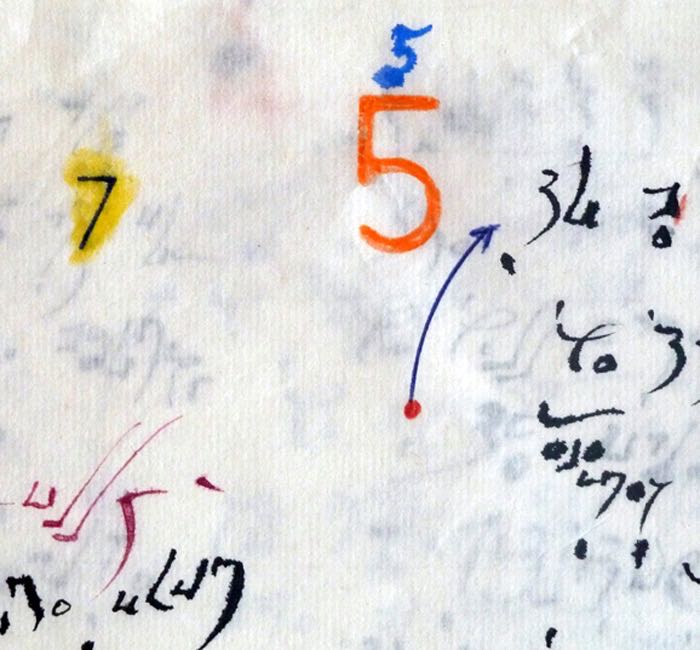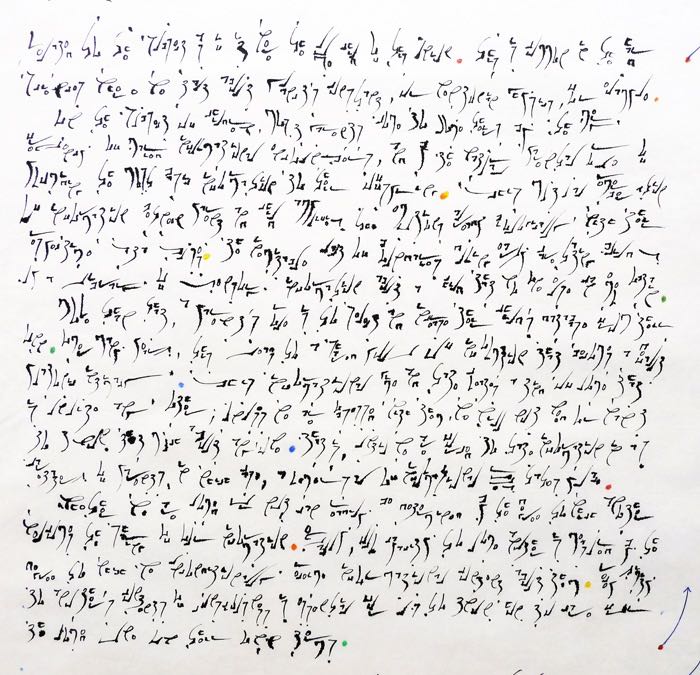Buy HD e-Books & Text —— www.ccelian.com
the Art of Nao
Scrolls: 1 . 2a . 2b . 3 . 4 . 5 . 6 . 7 . 8 . 9 . 10 . 11 . 12 . 13 . 14 . 15 . 16 . 17 .
18 . 19 . 20 . 21 . 22 . 23 . 24 . 25 . 26 . 27 . 28 . 29 . 30 . 31 . 32 . 33 . 34 .
< Scroll 4 ____________________________________________________ Scroll6 >


____________Scroll 5 . 66 x 135 cm / 26 x 53 inches___________

Scroll 5-section 1.1
7 Love... Tell Me More
The sensation of being in love feels so wonderfully ecstatic that it rarely occurs to us that love’s effects come from wanting more information—of all kinds—about the beloved. Without hesitation, love avidly reaches for the next interaction with the beloved in order to receive evermore information in all possible forms: sights, smells, tastes, touches, fantasies, sounds.
Our splendid love-based emotions come from our desires to sensually experience increasing aspects of what, or who, we love. The ardent lover will take on challenges and obstacles to increase their informational content regarding the beloved. Opportunities to do so are sought out, if not forced into being to the point of obsession.
Paradoxically then, love is not first about the beloved, but about how our love for them affects us. Love feels as it does because, by unconditionally accepting all information, our being cannot help but expand beyond its usual limits. In love, we are liberated into new experiences and so, surprising ways of viewing and experiencing life.
______________________

Scroll 5-section 1.2
To love and to feel loved inspires a thirst in us for more of our own authenticity. As we act to our optimal capacities and incorporate life’s offerings into a fresh wide-open self, this dynamic leads to release, relief, extension, and to a great surge of energy. Our self-reinvention then activates the latent potential that we’ve always had on our own, but were not sufficiently catalyzed or inspired to actualize.
In romantic love, we see ourselves freshly empowered through the eyes of the other and we no longer wish to safeguard the boundaries of our personal self. Instead, we offer an enormous degree of trust and remove from our nervous system many former protections against potential risks.
As a result, we are finally liberated from our own self-imposed limitations of identity and its insecurities. We are thus free to feel the fullness of our experiences in the now and encouraged to expand our self-definition.
It is this promising and pulsating rhythm of unrestrained expansion and contraction, of the systolic and diastolic pulse of a universe stretching out all around us that contributes to love’s intoxicating effects. We both inspire and are inspired. In extreme cases, everything else, but information about the love object, is immaterial.
_______________

Scroll 5-section 2.1
To be in love is that ultimate state in which we are fully surrounded and acted upon by love’s heartbeat; we take it as our own. Thus coupled, our heart becomes the hub that receives experiences of the beloved through all the channels accessible.
Nothing is too much to do or to go through for the sake of our love. We feel no pain in the sense of boundaries overstepped: their dissolution does not activate any defenses in us. We are willingly open to greater reception as we invite entry of the beloved’s information into all parts of our being. This is why tokens of love have such power. Anything that can be associated with the love object becomes a way to experience them.
When love is requited, the synergy of self-expansion goes both ways. The feelings of each person are vastly increased according to the lengths that their unified selves are willing to go in order to receive ever more information about one another.
As with fireworks, the trajectories of our emotions come in many styles, but the dynamic of latent potential released alongside their exciting effects is true to all. A person’s stimulated state also matches the motions of an electron following excitation from a source—heat in the case of an electron, and a beloved in the case of a person.
__________________

Scroll 5-section 2.2
In both instances, the external stimulus causes the electron/person to move to a higher level of energy. As each falls back to their less excited state, they release the energy of that higher one and throw off a spark. This literally becomes light in a lamp and, in a lover, it turns into heartfelt action, effort, self-sacrifice, stars in the eyes.
Our being can be made to expand through a variety of loves, not just through romantic ones. The territory of each will be different according to which systems within us are activated: emotional, intellectual, spiritual, physical, or any combination of these.
To love a subject matter also triggers a similar release and self-expansion into unconditional sensual information. This kind of love welcomes any opportunity to increase the knowledge of what it loves: a field of study, a profession, a place, cats, toy ducks, you name it.
The love between a person and a subject of interest usually leads to willing self-sacrifice of one's own personal neurological spaces. Examples abound of how devotion to a subject matter adds to our knowledge about it, but not about its researcher beyond their name. In many instances, that name becomes associated with significant discoveries >
____________________

Scroll 5-section 3
> related to the subject as if it were the love child of this union. This is common in the hard sciences, where we talk about Planck's constant, or Newtonian physics, for example.
On the subject of children, most parents come to love theirs by the very frequency of varied informational encounters, and by the natural parental role of providing the most basic information to their offspring. This mutual reverberation of information between parent and child amplifies the emotions already biologically associated with parental love. The inevitable lack of boundaries during early caretaking builds up a library of sensory information about a child that no one else can ever have about them.
More than that, a parent's role is to select and increase their child's database from their own. Over many years, this leads to a shared pool of information and can easily become a form of platonic intimacy. This informational give and take creates a kind of love that is unlike any other. Unless we are obsessed with them, we will not need or want to know that much about anyone. That is, until we are forced to take in information as caretakers of parents, in which case a reversal of informational roles takes place.
Whether we are loved or not can readily be determined by the degree to which another welcomes the sharing of our information. Equally, our capacity to love another person is measured by the degree to which we unconditionally receive informational content about them. Receptivity to another’s contents of consciousness is essential for us to know how to care for the loved-one on their own terms.
____________________

Scroll 5-section 4
When someone says that they love, but resist taking on increasing information about the supposed beloved, then they either may not love enough, or they might fear intimacy, which amounts to the anxiety of being forced into emotional change. In other words: fear of losing control over the sensual information that they must process.
Intimacy is itself no guarantee of uninterrupted closeness. One of the reasons why once loving relationships disintegrate past a certain point, comes from getting to know more than we can neurologically integrate.
In the course of a, once, romantic, cohabitation, the pool of subject matter that we end up having information about is rarely based solely upon our preferences. It is sometimes even quite different from what we found attractive, or were shown during the courting phase. When living in close quarters, we have no choice but to be privy to knowledge about the other’s finances, the shortcomings of their lifestyle, their history, worries, character under stress, health issues, etc.
Consequently, the uncomfortable internal states that we experience from some aspects of this new information can spill over into our formerly successful interactions. We have now fallen out of love and into default intimacy.
Along that road, couples who separate often stop wanting to take in more information about one another. Their nervous system withdraws from having to >
_____________________________

Scroll 5-section 5
> factor in any favourable data. To the degree that there is an absence of love, you can be sure that there is also a corresponding degree of contraction.
Hate, in fact, is ardent resistance to any favourable information about a given subject. When we hate, we actively reject and shrink away from knowing more than we already do—which may not be much in the case of prejudices. We also seek to negate any validating content about something hated so as not to let our nervous system inadvertently hyperlink into any favourable assessments of it. We contract rather than expand. By inference, social or personal conditions that foster contraction are going to limit one’s capacity to love and, possibly, engender hate besides.
Even while in love, our receptivity to information can cease at any point where the content becomes genuinely distasteful or, contrary to values whose transgression degrades our self-image. At that point, we resist additional information about the other and revise what information we already have. This may not be easy to do, for we have already let down our neurological guard, and it takes time to immune our nerves from further influxes of information.
Those who keep taking in troublesome information about the other, either love them unconditionally or, are addicted to them. A mother emotionally shelters her criminally violent son, a lover adapts to the other’s dysfunction and becomes dysfunctional themselves. Either scenario is based on love because it keeps accepting information even when it leads to suffering. It may not be healthy, but it is love nonetheless, a dark intimacy.
Intimacy is a question of kind and degree. People who grow up in a shared household have it, either by preference or by default. Due to architectural constraints >
______________________

Scroll 5-section 6
> and to the inevitable statistics of frequent encounters under a variety of circumstances, household members obtain unsolicited information about one another's personal spaces: a bathroom door is left unlocked, one comes to breakfast without grooming, phone conversations are overheard, incompetence is unedited, and so on.
The difference between love and default intimacy is that, in the former, we willingly for information but with the latter, we cannot avoid it. Not all intimacy, is therefore, voluntary, nor is it an aspect of emotional love. Neither does all intimacy result in liking someone, even when there is love.
Not to distinguish between information gained from forced interactions and that gained from a willing reach for it, leads to the fallacy thought that all family members must like one another. This is unrealistic; a nervous system cannot be forced to like anything or anyone, because liking is a different kind of resonance from love. We like what is like us—congruence of neurology—but we may love what is completely different.
As described further on, right relationship is a question of right distance. Distance determines how much information is possible, and how powerfully it can be delivered. With further distance, our neurological input is naturally reduced. This results in having greater inner space, which then lets us be in touch with feelings that, in fact, may be favourable towards the other under the right circumstances. When a forced proximity comes to an end, what was once irritating can inspire a kind of retrospective acceptance, if not fondness—as when people die or move away.
< Scroll 4 ____________________________________________________ Scroll6 >
Scrolls: 1 . 2a . 2b . 3 . 4 . 5 . 6 . 7 . 8 . 9 . 10 . 11 . 12 . 13 . 14 . 15 . 16 . 17 .
18 . 19 . 20 . 21 . 22 . 23 . 24 . 25 . 26 . 27 . 28 . 29 . 30 . 31 . 32 . 33 . 34 .
Buy HD e-Books & Text —— www.ccelian.com
© C.C. Elian 2010 - 2016